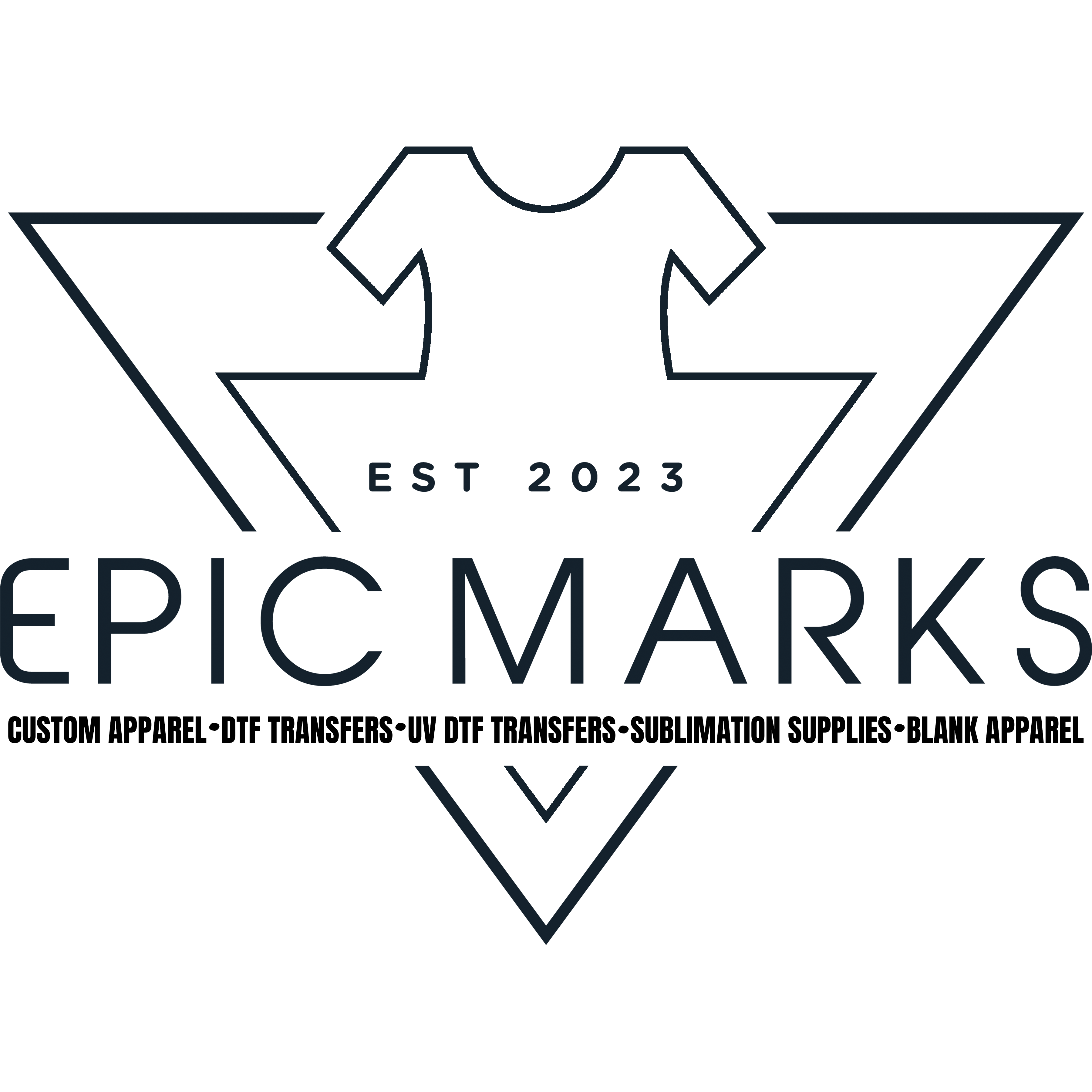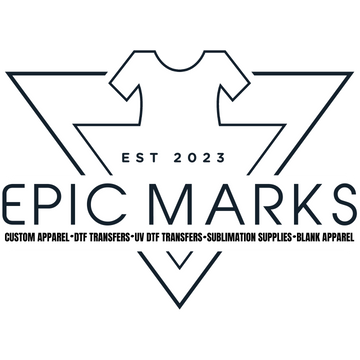Help
Sublimation
Compatible blanks, press settings, and care.
Compatible Blanks
Generic Material Information
Sublimation is picky — it only works on items that are made for it. If you try to sublimate on plain cotton or an uncoated mug, the print might look okay at first but it’ll wash right out. Always make sure your blank is labeled “sublimation ready.”
What works best: 100% polyester shirts, poly-coated ceramics and mugs, aluminum panels, glass with a sublimation coating, and neoprene blanks. These all have the special surface that allows sublimation ink to bond permanently.
What doesn’t work: cotton shirts, untreated metal, wood, or anything dark colored. Sublimation ink is transparent — so your design will disappear on dark surfaces.
Pro Tip: Light colors make the brightest prints. If you want rich, bold colors, stick with white or light-colored blanks.
Apparel
For shirts, hoodies, or other fabric items, polyester is your best friend. 100% polyester will give you the sharpest, most vibrant print. You can use blends, but don’t drop below 65% poly or your design will look faded before it even leaves the press.
Light colors are key. Sublimation ink is see-through, so it only shows up strong on white or pale fabrics. Dark shirts just don’t work — the ink has nothing to “show” against.
Before pressing, always lint-roll your garment. Those tiny fibers can leave blue fuzz spots in your design once the heat hits.
Mugs & Drinkware
Sublimation mugs and tumblers aren’t just “any mug.” They’re coated with a polyester finish that lets the ink transfer. Regular ceramic or stainless won’t hold a print, no matter how hot or long you press.
Before pressing, peel off any protective film (some blanks ship with a clear wrap). Double-check you’re working on the coated side — especially with specialty mugs or multi-surface items.
If you’re running a batch, follow the manufacturer’s instructions on stacking or padding. Every brand has its quirks, and a little prep will save you from ghosting or uneven transfers.
Metal Panels
Metal sublimation blanks usually come with a thin protective film. Always peel it off before pressing. If you forget, you’ll ruin both the print and the panel.
After removing the film, give the surface a quick wipe with a lint roller or rubbing alcohol. Let it dry completely before you press — even a little moisture will mess with the transfer.
Some panels need a pressing pad underneath to keep pressure even. Check the blank’s instructions before you start. And watch out — metal blanks stay hot much longer than fabric or ceramic. Handle with care after pressing.
Neoprene
Neoprene makes great sublimation products like koozies, mousepads, and keychains, but it comes with a few quirks. First off, make sure you’ve got good ventilation — neoprene can give off fumes when pressed. Some people even wear a vapor mask just to be safe.
Always lint-roll before pressing. Press one side at a time, and instead of heat tape (which can leave marks), use a light adhesive spray to keep your transfer in place. It holds just enough without leaving lines.
After pressing, lay the neoprene item flat under something heavy while it cools. This prevents curling and keeps the finished piece nice and flat.
Pressing
General Press Guidelines
Sublimation takes a little more heat and time than DTF, and every blank has its own sweet spot. The golden rule? Always check the manufacturer’s recommendations — but here are a few shop-tested basics:
- Always pre-press your blank for a few seconds to get rid of moisture and wrinkles.
- Use butcher paper or blowout paper above and below to catch stray ink and protect your press.
- Lock your design down with heat tape or spray so it can’t shift — ghosting is the #1 rookie mistake.
Helpful tip: Write down your settings when you find the “sweet spot.” Presses vary, and notes save you from guessing next time.
Apparel
For shirts, hoodies, and other poly fabric items, go hot and quick: 385–400°F for 45–60 seconds with medium pressure. 100% polyester gives you bold, vibrant colors. Anything below 65% poly will look faded, no matter what settings you use.
Lint-roll the fabric before pressing, then pre-press for 3–5 seconds to chase out moisture. Tear the edges of your transfer paper instead of cutting with scissors — this helps avoid harsh press lines. A pressing pillow under seams or zippers can make sure your design gets even pressure.
Mugs & Drinkware
Mugs love heat: press at 400°F for about 180 seconds in a mug press. Wrap the transfer tight and tape it securely — even a slight gap can leave blurry edges.
If you’re pressing multiple mugs, check the manufacturer’s stacking or padding instructions. Some blanks need a felt wrap or pressing pad between layers to keep the heat even.
Always make sure you’re pressing on the coated side of the mug — not all drinkware blanks are uniform.
Metal Panels
For aluminum and other coated metal panels, go with 400°F for about 60 seconds at medium pressure. Always peel off the protective film first — forgetting this step is a costly mistake.
Give the surface a quick wipe with alcohol or a lint roller and let it dry. Use butcher paper on top and bottom to protect your press, and follow the blank’s instructions for pressing pads — some require an extra cushion for best results.
When you’re done, remember: metal holds heat way longer than fabric or ceramic. Handle carefully — we’ve all learned that lesson the hard way.
Neoprene
Neoprene takes a little extra care. Press one side at a time at 400°F for 45–60 seconds with medium pressure. Use a light adhesive spray to hold your transfer in place instead of heat tape — tape can leave shiny marks on the surface.
Good ventilation is a must — neoprene can release vapors under heat. Once pressed, place the item under a heavy flat object as it cools to prevent curling.
Care
General
Sublimation prints are permanent — they won’t peel or crack — but how long they stay vibrant depends on how you treat them. Think of it like this: the better you care for it, the longer it’ll look brand new.
As a rule of thumb: avoid harsh chemicals, don’t expose items to extreme heat for long periods, and remember that constant sunlight will fade anything over time — even sublimation.
Apparel
Polyester shirts and garments need a little TLC to stay bright. Always wash inside-out in cold water with a mild detergent. Tumble dry low or hang dry for the best results.
Skip the bleach and fabric softeners. They break down polyester fibers and make your prints fade faster. And while sublimation won’t peel like vinyl, high heat and rough washes will still dull those colors over time.
Mugs & Drinkware
Sublimation mugs are tough, but the dishwasher isn’t gentle. Even “dishwasher safe” blanks will fade faster after repeated hot cycles.
For longest life, hand-wash with mild soap and a soft sponge. No steel wool, no harsh scrubbers. Treat it like your favorite coffee mug — because that’s exactly what it’ll be once your design is on it.
Hard Goods (Metal, Panels, Neoprene)
Metal panels, neoprene items, and coated boards are all easy to care for — just keep it simple. Wipe with a soft cloth and a gentle cleaner when needed.
Avoid abrasive pads or strong chemicals that can scratch coatings or dull the surface. Neoprene koozies and mousepads can usually be spot-cleaned with mild soap and water — just make sure they dry flat so they don’t curl up.
Troubleshooting
General Issues
My colors look dull
First thing to check is your settings. Sublimation needs high heat and the right amount of time. If your press ran cool or you pulled it too early, colors will fall flat. Also make sure you’re working with sublimation-ready blanks — regular cotton or uncoated mugs simply can’t hold vibrant ink.
I see ghosting or shadows
That’s almost always from the transfer shifting during the press. Lock your design down with heat tape or spray, and when you open and close the press, do it smoothly. A quick jerk can move the paper just enough to double the image.
Apparel
The print looks faded
Check the polyester content of your shirt. Anything below 65% poly won’t ever look bright, no matter the temp or time. Stick to 100% polyester for the most vivid results.
I see press marks around the design
This happens when the edge of the transfer paper leaves a line. Tear the edges of your paper instead of cutting with scissors — the feathered edge helps blend the heat so it doesn’t leave a sharp square.
Mugs & Drinkware
The image looks patchy
Make sure your transfer is wrapped tight and taped securely. Any gaps between the paper and mug can leave faded spots or blurry edges.
My mug faded after a few washes
Even “dishwasher safe” coatings can fade with repeated high-heat cycles. Hand-washing with a soft sponge will keep your colors looking better, longer.
Metal Panels
The print didn’t transfer fully
Double-check that you peeled off the protective film before pressing — it’s an easy step to miss. Also make sure the surface is clean and completely dry before you start.
The panel scorched or discolored
Metal holds heat longer than other materials, which makes it easy to overcook. Stick to the recommended press time and use a pressing pad if suggested by the blank’s instructions.
Neoprene
My item curled up after pressing
That’s normal for neoprene — it wants to curl while it’s still hot. Lay it flat under something heavy while it cools, and it’ll settle back into shape.
I see shiny marks where I taped
Heat tape can leave a glossy spot on neoprene. Use a light spray adhesive instead to hold your design in place without leaving marks.

